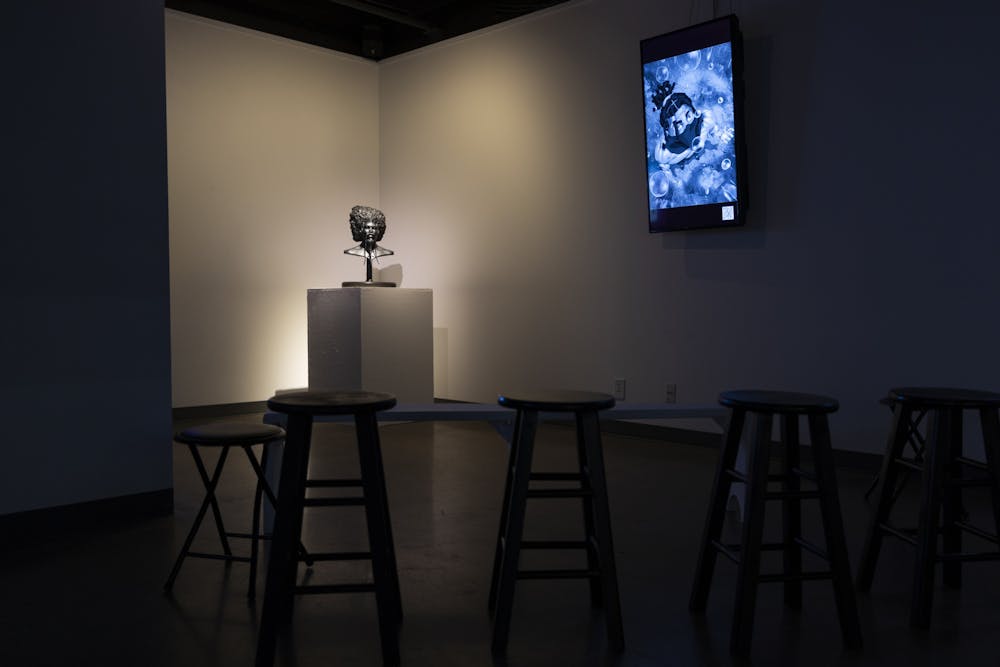Online and West campus students are learning different skills to create art across boundaries and disciplines.
The School of Humanities, Arts, and Cultural Studies opened "IndigoShado: Legends" in the ArtSpace West Gallery on Sept. 6, the first of a series of events this year showcasing the creative work of students, alumni and faculty in the Interdisciplinary Arts and Performance degree program.
At the exhibition, which runs until Sept. 27, digital art, sculpture and an original music score cooperate in the storytelling of a mythical world of legendary gods. Creative director and composer Kristian Williams, who graduated from ASU in 2017 with a bachelor's and 2020 with a master's both in IAP, partnered with sculptor Jorge De La Torre, illustrators Ardy Reapz and Angelo Chaib, co-producer and mixer Emilio Vargas and singer/songwriter Taylor Edoria.
Williams originally entered the IAP program hoping to someday create scores for original movies.
"My taste for making music for other people's movies kind of died down a little bit, and so writing my own stories and stuff like that, this program lent all the conceptual tools to do that," Williams said.
Now Williams is a resident artist at Onyx Art Gallery in Downtown Phoenix. This is where "IndigoShado: Legends" originally opened as one of three multimedia series.
According to Marianne Kim, a professor of Interdisciplinary Arts and Performance and associate director of the School of Humanities, Arts and Cultural Studies, the IAP program on the West campus provides a tight-knit community for students living and studying on the growing campus.
"Everyone knows the students’ names, which we are happy that we have that to offer a very personalized experience," Kim said.
Kim and other faculty wandered about the gallery on opening night, chatting casually with the artists and students in attendance. There are about 125 online students and about 30 on campus students in the program this year, Kim said.
Kim said the small IAP faculty is unique because they are dedicated to challenging each other to work across each other's distinct disciplines. The innovative and collaborative approach to teaching sets the IAP program apart from other arts degree programs.
"I have degrees in music and theater, and there are very few places where you don't have to choose one or the other," said Jeffery Kennedy, an associate professor with the School of Humanities, Arts and Cultural Studies.
Kennedy said that in his role he watches students try a little bit of every art form. He never expects students to be good at everything, but to try everything. By the end of the bachelor's program, when students complete their senior project, he said he never sees two projects that are the same.
"The whole idea of interdisciplinarity is it has transformative results," Kennedy said. "Something new will be created that has never been created before."
The disciplines that students participate in include visual art, movement, sound, media and even gaming.
Nkajima Ejire, who is studying IAP, experienced this challenge of the program.
"I usually don't like to step out of my comfort zone," Ejire said. "But I realized really quickly with this major that's kind of the point."
Ejire originally entered the program with an interest in filmmaking, but recently got involved in an upcoming evening of short plays directed by Charles St. Clair titled "Lights Up" to learn about stage lighting, directing and working with the theater community.
"We believe that one art form informs the other," said St. Clair, a technical director at the School of Humanities, Arts and Cultural Studies and Fine Arts specialist at the IAP program.
The School of Humanities, Arts and Cultural Studies currently hosts the stage creations of the IAP students and faculty in an 88-seat black box theater. In the past, the IAP faculty have worked with iTheater Collaborative to open shows at the Herberger Theater in downtown Phoenix.
As the program grows, St. Clair said he hopes to see the West campus receive funding for a larger theater to cater to the needs of the west Phoenix and Glendale art community. Kim said she hopes to foster relationships with art galleries around Phoenix, such as the Onyx Art Gallery.
St. Clair said prospective students and parents often ask him what a person can do with an IAP degree.
"My answer usually is whatever you'd like, but more importantly, what can't you do with a program and a degree in Interdisciplinary Arts?" St. Clair said. "Our students are in California, making films. Our students are all over the country."
Edited by Shane Brennan, Camila Pedrosa, Angelina Steel.
Reach the reporter at spbracci@asu.edu and follow @SophiaBraccio on X.
Like The State Press on Facebook and follow @statepress on X.
Sophia is a sophomore studying journalism and mass communication. This is her third semester with The State Press. She has also worked at Nomads with Notebooks and Blaze Radio.




